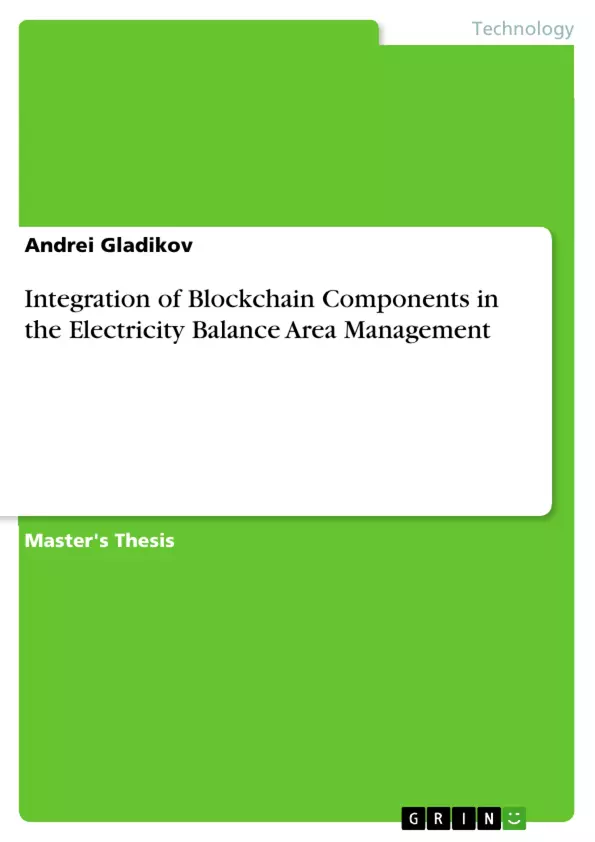This thesis is aimed to estimate the severity of recent balancing costs fallen onto balancing responsible parties (BRPs), the quality of forecast incentive, and prove a blockchain-based secondary flexibility market with quota mechanism of trading activation rights an efficient and economically viable tool for BRPs for offsetting schedule deviations at short notice. After developing a prosumer-enabled model which is system integrated complying with existing balancing management, various scenarios of deviations exchange are emulated.
The focus of this work is set to justify the sufficiency of strategic value in blockchain technology as the market underlying infrastructure and as a complementary layer for the established data exchange platform. This thesis identifies blockchain benefits and regulatory challenges for synchronization of multiple flexibility providers, creating and managing deviations-conscious balancer communities, resulting in energy balancing costs reduction, enabling innovative business models and additional revenue streams for balancing groups.
The increasing uncertainty of the power supply in Germany due to the surge in fluctuating renewable energy, power plant failures and accidental changes in consumption lead to the energy system imbalance. This not only threatens the system security, but also turns into financially punitive consequences for energy market players. Current market-based solutions and the German established data exchange platform with market rules ‘MaBiS’ do not foster a bottom-up collaboration in balancing groups to timely offset schedule deviations. The capability to modify and/or shift consumption of industrial or commercial end-customers as well as to adjust energy output of generation units gives a unique opportunity for organizing a shared platform for flexibility services exchange to mitigate the risk of paying imbalance tariff.
Inhaltsverzeichnis (Table of Contents)
- Abstract
- Keywords
- List of Figures
- List of Tables
- 1 Introduction
- 1.1 Motivation and Context
- 1.2 Research Questions
- 1.3 Scope and Structure of this Thesis
- 2 Technical and Market Background
- 2.1 Blockchain Fundamentals
- 2.1.1 Architecture
- 2.1.2 Consensus Mechanisms
- 2.1.3 Blockchain Properties
- 2.1.4 Types of Blockchains
- 2.2 Power System Balancing in Germany
- 2.2.1 Electricity Market Structure
- 2.2.2 Balancing Responsibility and Group Management
- 2.2.3 Data Exchange Platform and Balancing Market Rules in Germany
- 2.2.4 The Importance of Schedule Accuracy
- 3 Analyzing Imbalance in Germany
- 3.1 Data Acquisition and Processing
- 3.2 Analyzing Load Deviation Trends in Germany
- 3.3 Exploring Imbalance Prices in Germany
- 3.3.1 The Structure of Balancing Costs
- 3.3.2 Factors Affecting Imbalance Prices
- 3.4 Investigating Forecast Incentives in the German Balancing Market
- 3.4.1 The Role of the reBAP
- 3.4.2 Analysis of the reBAP Effectiveness
- 4 Demand Response and its Current Status in Germany
- 4.1 Definition and Scope
- 4.2 Demand Response Business Models
- 4.3 Regulatory Landscape for Demand Response in Germany
- 4.4 Barriers for Demand Response Implementation in Germany
- 5 Blockchain-based Flexibility Trading
- 5.1 Blockchain Adoption for Energy Management
- 5.1.1 Advantages of Blockchain in Energy Trading
- 5.1.2 Existing Blockchain Applications in Energy
- 5.2 Conceptual Framework for a Blockchain-based Flexibility Market
- 5.2.1 Blockchain Technology Integration
- 5.2.2 Service Model for P2P Flexibility Exchange
- 5.3 Simulation and Analysis of the Blockchain-based Secondary Flexibility Market
- 5.3.1 Scenario Design
- 5.3.2 Emulation of Market Interactions
- 5.3.3 Evaluation of Market Performance
- 5.4 Discussion of Economic Viability and Benefits
- 6 Conclusions and Recommendations
Zielsetzung und Themenschwerpunkte (Objectives and Key Themes)
This thesis aims to explore the potential of blockchain technology to improve flexibility management in the German electricity balancing market. It investigates the current challenges in balancing, analyzes the effectiveness of existing market mechanisms, and proposes a blockchain-based framework for facilitating flexible energy exchange.
- Integration of Blockchain in Electricity Balancing
- Analysis of Imbalance Costs and Market Incentives
- Exploring the Role of Demand Response
- Developing a Blockchain-based Flexibility Market
- Evaluating the Economic Viability and Benefits of Blockchain Adoption
Zusammenfassung der Kapitel (Chapter Summaries)
The thesis begins by providing a thorough introduction to the concepts of blockchain technology and electricity balancing in Germany. It delves into the technical aspects of blockchain, including its architecture, consensus mechanisms, and various types. The chapter then explores the structure of the German electricity market, focusing on balancing responsibility, group management, and data exchange platforms.
Chapter 3 analyzes recent imbalance trends in Germany, examining load deviation patterns, imbalance prices, and the effectiveness of existing market mechanisms. It investigates the role of forecast incentives in the German balancing market and analyzes the reBAP mechanism.
Chapter 4 explores the concept of demand response, its various business models, and its current status in Germany. It discusses the regulatory landscape for demand response and identifies key barriers to its implementation in the German market.
Finally, Chapter 5 proposes a blockchain-based framework for facilitating flexible energy exchange in the German balancing market. It outlines the advantages of blockchain technology in this context, presents a conceptual framework for a blockchain-based flexibility market, and analyzes the economic viability and benefits of this approach.
Schlüsselwörter (Keywords)
The core topics of this thesis revolve around the intersection of blockchain technology, energy balancing, and flexibility management in the context of the German electricity market. Key concepts include: balancing group management, balancing responsible party, electricity balancing market, imbalance price, energy blockchain, service model, prosumer. The work investigates the potential of blockchain to foster a decentralized and efficient market for flexibility services, aiming to reduce balancing costs and promote innovative business models in the energy sector.
- Citation du texte
- Andrei Gladikov (Auteur), 2019, Integration of Blockchain Components in the Electricity Balance Area Management, Munich, GRIN Verlag, https://www.grin.com/document/465312



